United States Secretary of the Air Force
Statutory office and the head of the U.S. Department of the Air Force From Wikipedia, the free encyclopedia
The secretary of the Air Force, sometimes referred to as the secretary of the Department of the Air Force,[1] (SecAF, or SAF/OS) is the head of the Department of the Air Force and the service secretary for the United States Air Force and United States Space Force. The secretary of the Air Force is a civilian appointed by the president, by and with the advice and consent of the Senate.[2] The secretary reports to the secretary of defense and/or the deputy secretary of defense, and is by statute responsible for and has the authority to conduct all the affairs of the Department of the Air Force.[2][3]
| United States Secretary of the Air Force | |
|---|---|
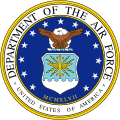 Seal of the Department of the Air Force | |
 Flag of the secretary | |
| Department of the Air Force | |
| Style | Mr. Secretary The Honorable (formal address in writing) |
| Reports to | Secretary of Defense Deputy Secretary of Defense |
| Appointer | The President with the advice and consent of the Senate |
| Term length | No fixed term |
| Precursor | Secretary of War |
| Inaugural holder | Stuart Symington |
| Formation | September 18, 1947 |
| Succession | 3rd in SecDef succession |
| Deputy | The Under Secretary (principal civilian deputy) The Chief of Staff (military deputy) The Chief of Space Operations (military deputy) |
| Salary | Executive Schedule, Level II |
| Website | office%20of%20the%20secretary |
The secretary works closely with their civilian deputy, the under secretary of the Air Force; and their military deputies, the chief of staff of the Air Force and the chief of space operations.
The first secretary of the Air Force, Stuart Symington, was sworn in on September 18, 1947, upon the split and re-organization of the Department of War and Army Air Forces into an air military department and a military service of its own, with the enactment of the National Security Act.
On July 26, 2021 the United States Senate confirmed Frank Kendall III as the next secretary of the Air Force. On July 28, 2021, Kendall was sworn in as the 26th secretary of the Air Force.
Responsibilities
Summarize
Perspective
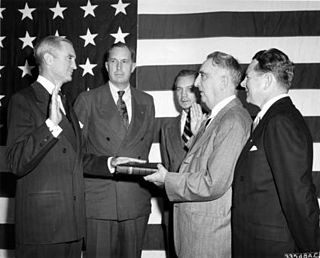
The secretary is the head of the Department of the Air Force. The Department of the Air Force is defined as a Military Department.[4] It is not limited to the Washington headquarters staffs, rather it is an entity which includes all the components of the United States Air Force and United States Space Force, including their reserve components:
The term 'department', when used with respect to a military department, means the executive part of the department and all field headquarters, forces, reserve components, installations, activities, and functions under the control or supervision of the Secretary of the department.[5]
The exclusive responsibilities of the secretary of the Air Force are enumerated in of the United States Code. They include, but are not limited to:
(1) Recruiting.
(2) Organizing.
(3) Supplying.
(4) Equipping (including research and development).
(5) Training.
(6) Servicing.
(7) Mobilizing.
(8) Demobilizing.
(9) Administering (including the morale and welfare of personnel).
(10) Maintaining.
(11) The construction, outfitting, and repair of military equipment.(12) The construction, maintenance, and repair of buildings, structures, and utilities and the acquisition of real property and interests in real property necessary to carry out the responsibilities specified in this section.[3]
By direction of the secretary of defense, the secretary of the Air Force assigns military units of the Air Force and Space Force, other than those who carry out the functions listed in , to the Unified and Specified Combatant Commands to perform missions assigned to those commands. Air Force and Space Force units while assigned to Combatant Commands may only be reassigned by authority of the secretary of defense.[6]
However, the chain of command for Air Force and Space Force units for other purposes than the operational direction goes from the president to the secretary of defense to the secretary of the Air Force to the commanders of Air Force and Space Force Commands.[7] Air Force and Space Force officers have to report on any matter to the secretary, or the secretary's designate, when requested. The secretary has the authority to detail, prescribe the duties, and to assign Air Force and Space Force service members and civilian employees, and may also change the title of any activity not statutorily designated.[8] The secretary has several responsibilities under the Uniform Code of Military Justice (UCMJ) with respect to Air Force and Space Force service members, including the authority to convene general courts martial and to commute sentences.
The secretary of the Air Force may also be assigned additional responsibilities by the president or the secretary of defense,[9] e.g. the secretary is designated as the "DoD Executive Agent for Space", and as such:
... shall develop, coordinate, and integrate plans and programs for space systems and the acquisition of DoD Space Major Defense Acquisition Programs to provide operational space force capabilities to ensure the United States has the space power to achieve its national security objectives.[10][11]
Office of the Secretary of the Air Force
Summarize
Perspective
 | |
| Agency overview | |
|---|---|
| Formed | 1947 |
| Headquarters | Pentagon |
| Parent agency | Department of the Air Force |

The secretary of the Air Force's principal staff element, the Office of the Secretary of the Air Force, has responsibility for acquisition and auditing, comptroller issues (including financial management), inspector general matters, legislative affairs, and public affairs within the Department of the Air Force. The Office of the Secretary of the Air Force is one of the Department of the Air Force's three headquarter staffs at the seat of government, with the others being the Air Staff and the Office of the Chief of Space Operations.
Composition
The Office of the Secretary of the Air Force is composed of:
- Under Secretary of the Air Force
- The Deputy Under Secretary of the Air Force for International Affairs
- The Deputy Under Secretary of the Air Force for Space Programs
- Assistant Secretary of the Air Force for Acquisition, Technology and Logistics
- Assistant Secretary of the Air Force for Financial Management and Comptroller
- Assistant Secretary of the Air Force for Installations, Environment and Energy
- Assistant Secretary of the Air Force for Manpower and Reserve Affairs
- Assistant Secretary of the Air Force for Space Acquisition and Integration[12]
- General Counsel of the Department of the Air Force
- Inspector General of the Air Force
- Chief of Legislative Liaison
- Administrative Assistant to the Secretary of the Air Force
- Auditor General of the Department of the Air Force
- Air Reserve Forces Policy Committee
List of secretaries of the Air Force
| No. | Image | Name | Start | End | Duration | President(s) | |
|---|---|---|---|---|---|---|---|
| 1 |  |
Stuart Symington | September 18, 1947 | April 24, 1950 | 2 years, 218 days | Harry S. Truman (1945–1953) | |
| 2 |  |
Thomas K. Finletter | April 24, 1950 | January 20, 1953 | 2 years, 271 days | ||
| 3 |  |
Harold E. Talbott | February 4, 1953 | August 13, 1955 | 2 years, 190 days | Dwight D. Eisenhower (1953–1961) | |
| 4 |  |
Donald A. Quarles | August 15, 1955 | April 30, 1957 | 1 year, 258 days | ||
| 5 | 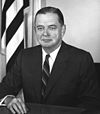 |
James H. Douglas Jr. | May 1, 1957 | December 10, 1959 | 2 years, 223 days | ||
| 6 |  |
Dudley C. Sharp | December 11, 1959 | January 20, 1961 | 1 year, 40 days | ||
| 7 |  |
Eugene M. Zuckert | January 24, 1961 | September 30, 1965 | 4 years, 249 days | John F. Kennedy (1961–1963) | |
| Lyndon B. Johnson (1963–1969) | |||||||
| 8 |  |
Harold Brown | October 1, 1965 | February 15, 1969 | 3 years, 137 days | ||
| Richard Nixon (1969–1974) | |||||||
| 9 | 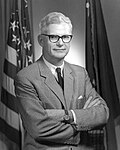 |
Robert C. Seamans Jr. | February 15, 1969 | May 15, 1973 | 4 years, 89 days | ||
| 10 |  |
John L. McLucas | May 15, 1973 | July 18, 1973 | 2 years, 192 days | ||
| July 18, 1973 | November 23, 1975 | ||||||
| Gerald Ford (1974–1977) | |||||||
| 11 |  |
Thomas C. Reed | January 2, 1976 | April 6, 1977 | 1 year, 94 days | ||
| Jimmy Carter (1977–1981) | |||||||
| 12 |  |
John C. Stetson | April 6, 1977 | May 18, 1979 | 2 years, 42 days | ||
| 13 | 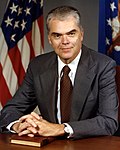 |
Hans Mark | May 18, 1979 | July 26, 1979 | 1 year, 267 days | ||
| July 26, 1979 | February 9, 1981 | ||||||
| Ronald Reagan (1981–1989) | |||||||
| 14 |  |
Verne Orr | February 9, 1981 | November 30, 1985 | 4 years, 294 days | ||
| 15 |  |
Russell A. Rourke | December 9, 1985 | April 6, 1986 | 118 days | ||
| 16 |  |
Edward C. Aldridge Jr. | April 6, 1986 | June 8, 1986 | 2 years, 254 days | ||
| June 9, 1986 | December 16, 1988 | ||||||
| – |  |
James F. McGovern | December 16, 1988 | April 29, 1989 | 134 days | ||
| George H. W. Bush (1989–1993) | |||||||
| – |  |
John J. Welch Jr. | April 29, 1989 | May 21, 1989 | 22 days | ||
| 17 |  |
Donald B. Rice | May 21, 1989 | January 20, 1993 | 3 years, 244 days | ||
| – |  |
Michael B. Donley Acting |
January 20, 1993 | July 13, 1993 | 174 days | Bill Clinton (1993–2001) | |
| – |  |
Merrill A. McPeak Acting |
July 14, 1993 | August 5, 1993 | 22 days | ||
| 18 |  |
Sheila Widnall | August 6, 1993 | October 31, 1997 | 4 years, 86 days | ||
| 19 |  |
F. Whitten Peters | November 1, 1997 | July 30, 1999 | 3 years, 80 days | ||
| July 30, 1999 | January 20, 2001 | ||||||
| – |  |
Lawrence J. Delaney Acting |
January 21, 2001 | May 31, 2001 | 130 days | George W. Bush (2001–2009) | |
| 20 |  |
James G. Roche | June 1, 2001 | January 20, 2005 | 3 years, 233 days | ||
| – |  |
Peter B. Teets Acting |
January 20, 2005 | March 25, 2005 | 64 days | ||
| – |  |
Michael Montelongo Acting |
March 25, 2005 | March 28, 2005 | 3 days | ||
| – |  |
Michael L. Dominguez Acting |
March 28, 2005 | July 29, 2005 | 123 days | ||
| – |  |
Pete Geren Acting[13] |
July 29, 2005 | November 4, 2005 | 98 days | ||
| 21 | 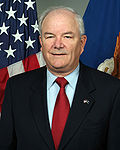 |
Michael Wynne[14] | November 4, 2005 | June 20, 2008 | 2 years, 229 days | ||
| 22 |  |
Michael B. Donley | June 21, 2008 | October 2, 2008 | 5 years, 0 days | ||
| October 2, 2008 | June 21, 2013 | ||||||
| Barack Obama (2009–2017) | |||||||
| – |  |
Eric Fanning Acting |
June 21, 2013 | December 20, 2013 | 182 days | ||
| 23 |  |
Deborah Lee James | December 20, 2013 | January 20, 2017 | 3 years, 31 days | ||
| – | 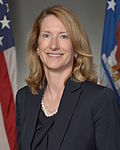 |
Lisa Disbrow Acting |
January 20, 2017 | May 16, 2017 | 116 days | Donald Trump (2017–2021) | |
| 24 | 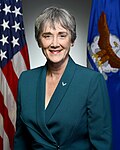 |
Heather Wilson | May 16, 2017 | May 31, 2019 | 2 years, 15 days | ||
| – |  |
Matthew Donovan Acting |
June 1, 2019 | October 18, 2019 | 139 days | ||
| 25 |  |
Barbara Barrett | October 18, 2019 | January 20, 2021 | 1 year, 94 days | ||
| – |  |
John P. Roth Acting |
January 20, 2021 | July 28, 2021 | 189 days | Joe Biden (2021–2025) | |
| 26 |  |
Frank Kendall III | July 28, 2021 | January 20, 2025 | 3 years, 176 days | ||
| – |  |
Gary A. Ashworth Acting |
January 20, 2025 | Incumbent | 82 days | Donald Trump (2025–present) | |
See also
References
- Title 10 United States Code
- Subtitle A – General Military Law
- CHAPTER 1 – DEFINITIONS
- § 101. Definitions
- CHAPTER 6 – COMBATANT COMMANDERS
- § 162. Combatant command: assigned forces; chain of command
- CHAPTER 1 – DEFINITIONS
- Subtitle D – Air Force
- CHAPTER 903 – DEPARTMENT OF THE AIR FORCE
- § 9011. Organization
- § 9013. Secretary of the Air Force
- § 9014. Office of the Secretary of the Air Force
- § 9015. Under Secretary of the Air Force
- CHAPTER 905 – THE AIR STAFF
- § 9032. The Air Staff: general duties
- § 9033. Chief of Staff
- CHAPTER 903 – DEPARTMENT OF THE AIR FORCE
- Subtitle A – General Military Law
- Executive Order 12909, Order of Succession of Officers To Act as Secretary of the Air Force
- Department of Defense Directive (DODD) 5100.1, Functions of the Department of Defense and Its Major Components, August 1 2002.
- Department of Defense Directive (DODD) 5101.2, DoD Executive Agent for Space, June 3 2003.
Notes
External links
Wikiwand - on
Seamless Wikipedia browsing. On steroids.

